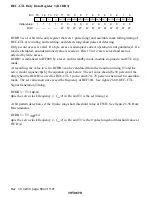
Rev. 1.0, 02/00, page 701 of 1141
26.13.6
Operation
CTL Circuit Operation: As shown in figure 26.49, the CTL discrimination/record circuit is
composed of a 16-bit up/down counter and 12-bit registers (
×
5).
In playback (PB) mode, the 16-bit up/down counter counts on a
φ
s/4 clock when the PB-CTL
pulse is high, and on a
φ
s/5 clock when low. In record or slow mode, this counter increments the
count on a
φ
s/4 clock. In ASM mode, this counter increments the count on a
φ
s/8 clock when the
pulse is high, and on a
φ
s/4 clock when low.
This counter always counts up in record and slow modes.
In playback or slow mode, it is cleared on the rise of PB-CTL signal. In record mode, it is cleared
on the rise of REF30X signal.
φ
s/4
(
φ
s/8)
φ
s/5
(
φ
s/4)
REC-CTL
↓
(L0)
RCDR5
REC-CTL
↓
(S0)
RCDR4
REC-CTL
↓
(L1and ASM)
RCDR3
REC-CTL
↓
(S1)
RCDR2
REC-CTL
↑
Match
detection
Match
detection
Match
detection
Match
detection
Match
detection
RCDR1
12-bit register
UDF:
DOWN
UDF
Upper 12 bits
UP
UP/DOWN counter (16 bits)
Duty
detection
Counter clear signal
REF30X
↑
(REC)
PB-CTL
↑
(PB, ASM)
Up/Down control signal
REC: UP
PB, ASM:
UP when PB-CTL is high
Down when PB-CTL is low
Underflows when PB-CTL
duty is 44% or less
Figure 26.49 CTL Discrimination/Record Circuit
CTL Mode Register (CTLM) Switchover Timing: CTLM is enabled immediately after data is
written to the register. Care must be taken with changes in the operating state.
Capstan phase control is performed by the VD sync REF30X (X-value + tracking value) and PB-
CTL in ASM mode, and by the REF30P or CREF and CFG division signal (DVCFG2) in REC
mode. If CAPREF30 signal to be used for capstan phase control is always generated by XDR, the
value of XDR must be overwritten when switching between PB and REC modes. Figures 26.50
and 26.51 show examples of switch timing of CTLM and XDR.
















































